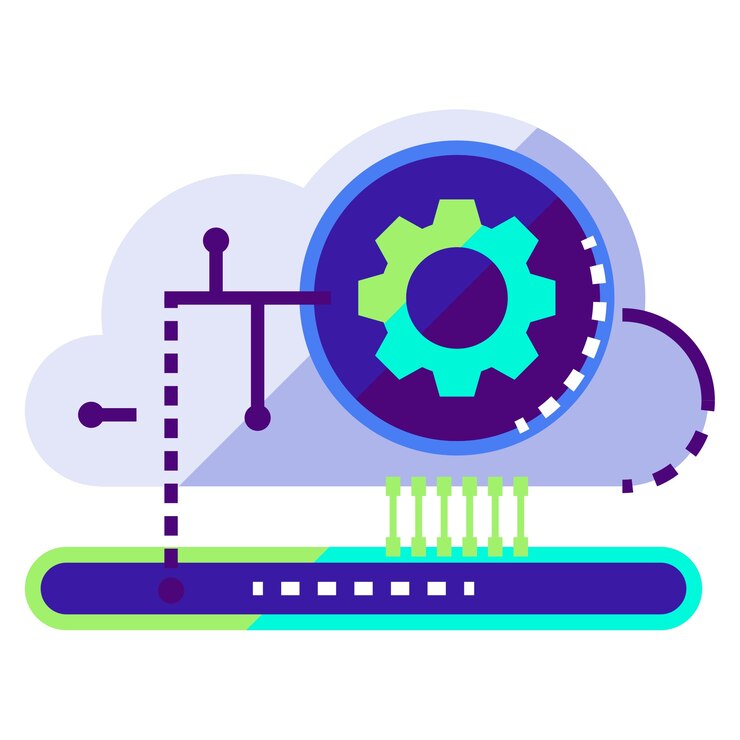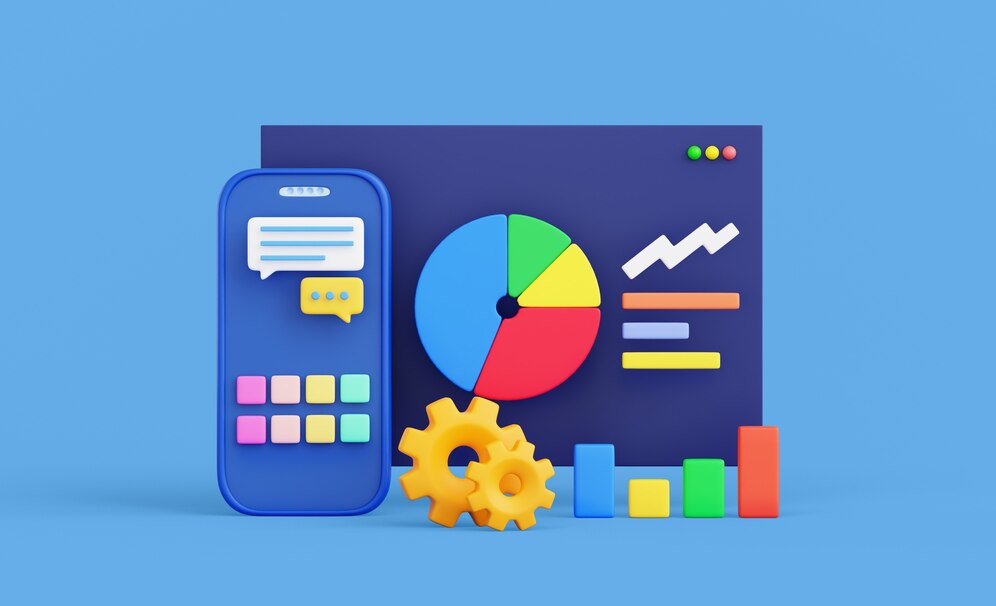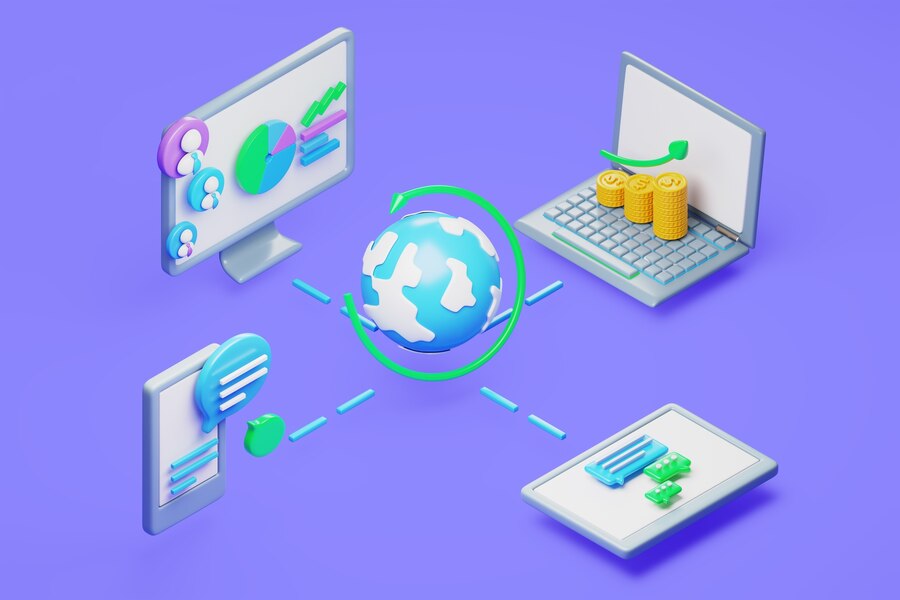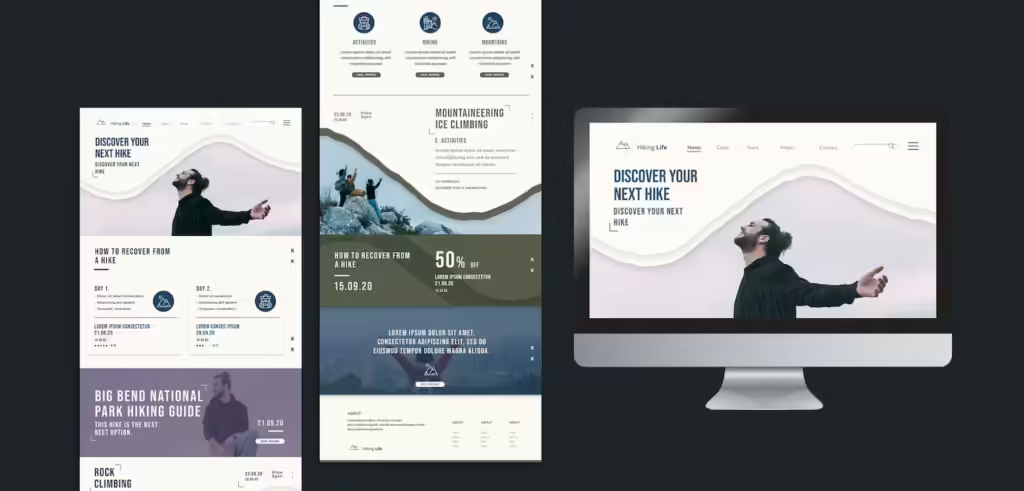Digital Marketing
Digital marketing is the use of digital channels, platforms, and technologies to promote products, services, and brands to target audiences. It encompasses various online tactics and strategies aimed at reaching and engaging customers in the digital realm. Here are some key components of digital marketing.
Website Optimization

Website optimization is the process of improving various aspects of a website to enhance its performance, user experience, and effectiveness in achieving its goals. Here are some key areas of website optimization.

Page Speed Optimization
Ensure that your website loads quickly on both desktop and mobile devices. This can be achieved by optimizing images, minifying CSS and JavaScript files, leveraging browser caching, and using a content delivery network (CDN) to reduce server response times.

Mobile Optimization
With a significant portion of web traffic coming from mobile devices, it’s crucial to optimize your website for mobile users. Use responsive design techniques to ensure that your site looks and functions well across different screen sizes and devices.

User Experience (UX) Design
Design your website with the user in mind, making it easy to navigate, visually appealing, and intuitive to use. This includes clear navigation menus, logical page layouts, and prominent calls-to-action (CTAs) to guide users towards desired actions.

Content Optimization
Create high-quality, relevant, and engaging content that meets the needs of your target audience. Use keyword research to optimize your content for search engines, but prioritize providing value to users over keyword stuffing.

On-Page SEO
Optimize each page of your website for search engines by using descriptive meta titles and descriptions, relevant headings (H1, H2, etc.), and optimizing image alt attributes. Ensure that your website follows SEO best practices to improve its visibility in search engine results.

Conversion Rate Optimization (CRO)
Analyze user behavior on your website to identify areas for improvement and test different elements (such as headlines, CTAs, and forms) to increase conversion rates. Use A/B testing and multivariate testing to experiment with different variations and determine what resonates best with your audience.

Website Security
Protect your website and its users from security threats by implementing HTTPS encryption, keeping software and plugins up to date, using strong passwords, and regularly scanning for vulnerabilities. Display trust signals, such as SSL certificates and security badges, to reassure visitors.

Optimized Forms and Checkout Process
Streamline forms and the checkout process to minimize friction and encourage conversions. Use autofill features, progress indicators, and clear error messages to make the process as smooth as possible.

Analytics and Tracking
Install website analytics tools, such as Google Analytics, to track key metrics such as traffic, user engagement, and conversion rates. Use this data to identify areas of improvement and make data-driven decisions to optimize your website further.

Accessibility
Ensure that your website is accessible to users with disabilities by following web accessibility standards (such as WCAG) and implementing features like alternative text for images, keyboard navigation, and text-to-speech compatibility.By continuously optimizing your website across these various dimensions, you can improve its performance, user experience, and ultimately, its ability to achieve your business objectives.
Search Engine Optimization (SEO)

Search Engine Optimization (SEO) is the process of improving a website’s visibility in search engine results pages (SERPs) in order to increase organic (non-paid) traffic. Here’s an overview of key aspects of SEO.
Keyword Research
Identify relevant keywords and phrases that your target audience is likely to use when searching for information related to your business. Use keyword research tools to discover search volumes, competition levels, and related keywords.

On-Page Optimization
Optimize individual pages of your website for target keywords. This includes optimizing meta titles, meta descriptions, headings (H1, H2, etc.), URL structures, and image alt attributes. Ensure that your content is high-quality, relevant, and provides value to users.

Content Creation
Create compelling and informative content that addresses the needs and interests of your target audience. This could include blog posts, articles, videos, infographics, and other forms of content. Aim to become a trusted resource in your industry and establish authority in your niche.

Technical SEO
Ensure that your website is technically optimized for search engines to crawl and index effectively. This includes optimizing site speed, mobile-friendliness, site architecture, URL structure, internal linking, and fixing any crawl errors or broken links.

Link Building
Build high-quality backlinks from reputable and relevant websites to improve your website’s authority and credibility in the eyes of search engines. Focus on earning natural, organic links through content marketing, guest blogging, influencer outreach, and other link building strategies.

Local SEO
If you have a physical location or serve a specific geographic area, optimize your website for local search. This includes claiming and optimizing your Google My Business listing, ensuring consistent NAP (Name, Address, Phone Number) information across online directories, and earning local citations.

User Experience (UX)
Provide a positive user experience on your website to keep visitors engaged and encourage them to explore further. This includes fast page load times, easy navigation, mobile responsiveness, and clear calls-to-action (CTAs).

Analytics and Monitoring
Use web analytics tools, such as Google Analytics and Google Search Console, to track your website’s performance, monitor keyword rankings, and identify areas for improvement. Regularly review and analyze data to make informed decisions and adjustments to your SEO strategy.

Algorithm Updates
Stay informed about changes to search engine algorithms and adapt your SEO strategy accordingly. Search engines like Google regularly update their algorithms to improve search results and combat spammy tactics, so it’s important to stay up-to-date with industry news and best practices.

Continuous Improvement
SEO is an ongoing process that requires continuous monitoring, testing, and optimization. Regularly review your SEO performance, experiment with different strategies and tactics, and adapt your approach based on data and insights.By focusing on these key aspects of SEO and implementing best practices, you can improve your website’s visibility in search engine results, attract more organic traffic, and ultimately, achieve your business goals.

Content Marketing

Content marketing is a strategic marketing approach focused on creating and distributing valuable, relevant, and consistent content to attract and retain a clearly defined audience—and, ultimately, to drive profitable customer action. Here’s a breakdown of key elements and strategies within content marketing:

Audience Research
Understand your target audience’s demographics, interests, pain points, and preferences. This helps tailor your content to resonate with their needs and motivations.

Content Strategy
Develop a content strategy that aligns with your business goals and audience needs. Determine the types of content you’ll create (e.g., blog posts, videos, infographics), the topics you’ll cover, and the channels you’ll use to distribute your content.

Content Creation
Produce high-quality, engaging content that provides value to your audience. This could include educational articles, how-to guides, case studies, customer testimonials, and more. Ensure that your content is well-written, visually appealing, and optimized for search engines.

Content Distribution
Promote your content through various channels to reach your target audience. This may include your website, blog, social media platforms, email newsletters, guest posts on other websites, and content syndication networks.
SEO Integration
Incorporate search engine optimization (SEO) best practices into your content to improve its visibility in search engine results. This includes keyword research, optimizing meta tags and headings, building internal and external links, and creating valuable, shareable content that attracts backlinks.

Social Media Marketing
Leverage social media platforms to distribute and amplify your content. Share your content regularly on social networks such as Facebook, Twitter, LinkedIn, Instagram, and Pinterest. Encourage engagement, shares, and discussions around your content.

Email Marketing
Use email marketing to nurture leads, build relationships, and drive traffic to your content. Send targeted email campaigns with valuable content, personalized recommendations, and calls-to-action (CTAs) that encourage subscribers to visit your website or take specific actions.

Measurement and Analytics
Track and measure the performance of your content marketing efforts using key metrics such as website traffic, engagement metrics (likes, shares, comments), conversion rates, and ROI. Use analytics tools such as Google Analytics, social media insights, and email marketing software to gain insights into what’s working and what can be improved.

Content Repurposing
Repurpose your content into different formats to reach new audiences and maximize its impact. For example, turn blog posts into videos, infographics, podcasts, or slide presentations. This allows you to extend the lifespan of your content and reach audiences on different platforms and channels.

Continuous Optimization
Continuously analyze and optimize your content marketing strategy based on data, feedback, and emerging trends. Experiment with different types of content, distribution channels, and messaging to identify what resonates best with your audience and drives the desired results.By implementing a well-planned content marketing strategy and consistently delivering valuable content to your audience, you can build trust, establish thought leadership, drive traffic and engagement, generate leads, and ultimately, grow your business.
Social Media Marketing

Social media marketing is a digital marketing strategy that involves using social media platforms to promote products, services, and brands, as well as engage with audiences and build relationships. Here’s an overview of key elements and strategies within social media marketing:
Audience Research
Understand your target audience’s demographics, interests, behaviors, and preferences on social media. This helps tailor your messaging and content to resonate with their needs and motivations.

Platform Selection
Choose the right social media platforms for your business based on where your target audience is most active. Popular platforms include Facebook, Instagram, Twitter, LinkedIn, Pinterest, Snapchat, TikTok, and YouTube. Each platform has its own unique features, audience demographics, and content formats.
Content Creation
Create compelling and engaging content that adds value to your audience’s social media experience. This could include a mix of visual content (images, videos, infographics), written content (blog posts, articles), and interactive content (polls, quizzes, contests). Use storytelling, authenticity, and creativity to capture attention and drive engagement.

Content Calendar
Plan and schedule your social media content in advance using a content calendar. This helps maintain consistency, ensure a steady flow of content, and align your messaging with key events, holidays, and marketing campaigns.
Community Engagement
Actively engage with your audience by responding to comments, messages, and mentions, and participating in conversations. Show genuine interest in your audience’s needs and opinions, and foster a sense of community around your brand.

Paid Advertising
Consider using paid advertising on social media platforms to increase reach, engagement, and conversions. Social media advertising options include sponsored posts, display ads, video ads, carousel ads, and influencer partnerships. Use targeting options (such as demographics, interests, behaviors, and custom audiences) to reach specific segments of your audience with relevant ads.

Influencer Marketing
Collaborate with influencers or content creators who have a strong following and influence within your target audience. Partnering with influencers can help amplify your brand’s message, reach new audiences, and build credibility and trust.

Analytics and Insights
Use social media analytics tools provided by each platform (such as Facebook Insights, Instagram Insights, Twitter Analytics) to track and measure the performance of your social media marketing efforts. Monitor key metrics such as reach, engagement, clicks, conversions, and ROI, and use insights to optimize your strategy and content.

Social Listening
Monitor social media conversations and mentions related to your brand, products, industry, and competitors. Use social listening tools to track brand mentions, sentiment, trends, and relevant keywords, and use the insights gained to inform your marketing strategy and decision-making.

Continuous Optimization
Continuously analyze and optimize your social media marketing strategy based on data, feedback, and emerging trends. Experiment with different types of content, posting times, ad formats, and targeting options to identify what resonates best with your audience and drives the desired results.By implementing a well-planned social media marketing strategy and consistently engaging with your audience, you can build brand awareness, increase customer loyalty, drive website traffic and conversions, and ultimately, achieve your business goals.

Email Marketing

Email marketing is a digital marketing strategy that involves sending emails to a targeted list of recipients with the goal of promoting products, services, or content, as well as nurturing leads and building relationships with customers. Here’s an overview of key elements and strategies within email marketing.

Audience Segmentation
Divide your email list into segments based on demographics, interests, purchase history, behavior, or other criteria. This allows you to send targeted and personalized emails that are relevant to each segment of your audience.

Email List Building
Grow your email list by capturing email addresses through website opt-in forms, lead magnets (such as ebooks, whitepapers, or webinars), social media, events, and other channels. Focus on obtaining permission from subscribers to send them emails and comply with applicable email marketing regulations (such as GDPR or CAN-SPAM).

Email Design
Create visually appealing and mobile-responsive email templates that are optimized for different devices and email clients. Use clear and compelling subject lines, preheaders, and email copy to grab attention and encourage recipients to open and engage with your emails.

Content Creation
Develop valuable and relevant content to include in your emails, such as promotional offers, product updates, blog posts, newsletters, customer testimonials, event invitations, and educational resources. Tailor your content to meet the needs and interests of your audience segments.
Personalization
Personalize your emails based on subscriber data and preferences, such as their name, past purchases, browsing behavior, or location. Use dynamic content, merge tags, and segmentation to deliver personalized messages that resonate with each recipient.

Automation
Set up automated email campaigns to deliver timely and relevant messages to subscribers based on triggers, actions, or predefined workflows. Common types of automated emails include welcome emails, abandoned cart reminders, order confirmations, post-purchase follow-ups, and re-engagement campaigns.

A/B Testing
Experiment with different elements of your emails, such as subject lines, sender names, content, CTAs, and sending times, through A/B testing (also known as split testing). Analyze the results to identify which variations perform best and optimize your email campaigns accordingly.

Metrics and Analytics
Track and measure the performance of your email campaigns using key metrics such as open rates, click-through rates, conversion rates, unsubscribe rates, and revenue generated. Use email marketing analytics tools to gain insights into subscriber engagement, behavior, and preferences.

Compliance and Deliverability
Ensure that your email marketing practices comply with relevant laws and regulations, such as GDPR, CAN-SPAM, and CASL. Follow best practices for email deliverability, such as using double opt-in confirmation, maintaining a clean email list, and avoiding spammy tactics.
Pay-Per-Click (PPC) Advertising

Pay-Per-Click (PPC) advertising is a digital advertising model in which advertisers pay a fee each time their ad is clicked. It’s a way of buying visits to your site rather than attempting to earn those visits organically. Here’s an overview of key elements and strategies within PPC advertising:
Keyword Research
Identify relevant keywords and phrases that your target audience is likely to use when searching for products or services related to your business. Use keyword research tools to discover search volumes, competition levels, and bid estimates.

Ad Campaign Setup
Create PPC advertising campaigns on platforms such as Google Ads (formerly known as Google AdWords), Bing Ads, Facebook Ads, LinkedIn Ads, Twitter Ads, and other ad networks. Define campaign settings such as budget, targeting options, ad schedule, and ad extensions.

Pay-Per-Click

Pay-Per-Click (PPC) advertising is a digital marketing model in which advertisers pay a fee each time one of their ads is clicked. It’s essentially a way of buying visits to your site, rather than attempting to “earn” those visits organically through methods like search engine optimization (SEO).
In PPC advertising, advertisers bid on keywords relevant to their target audience. When users search for these keywords on search engines like Google, Bing, or Yahoo, the search engine displays sponsored ads that are relevant to the search query. The position of these ads on the search engine results page (SERP) often depends on the bid amount and the quality score of the ad.
PPC advertising is commonly associated with search engine advertising, where advertisers bid on keywords, but it can also include display advertising and remarketing. In display advertising, ads appear on websites that are part of the ad network, usually in the form of banners or other visually appealing formats. Remarketing involves showing ads to people who have previously visited your website or interacted with your brand in some way.
The major PPC advertising platform is Google Ads, formerly known as Google AdWords, which allows advertisers to create ads that appear on Google’s search engine and its advertising network. Other platforms include Bing Ads (now known as Microsoft Advertising), which operates on Bing and Yahoo search engines, as well as social media platforms like Facebook, Twitter, LinkedIn, and Instagram, which offer their own PPC advertising solutions.
PPC advertising can be a highly effective way to drive targeted traffic to your website, increase brand awareness, and generate leads or sales. However, it requires careful management of campaigns, keyword selection, ad copywriting, and budget allocation to ensure a positive return on investment (ROI).
Influencer Marketing

Influencer marketing is a type of digital marketing strategy that involves collaborating with individuals who have a significant following and influence on social media platforms to promote products, services, or brands to their audience. These individuals, known as influencers, typically have a loyal and engaged fan base within a specific niche or industry.
Here’s how influencer marketing generally works:

Identifying Influencers
Marketers identify influencers who align with their brand values, target audience, and marketing objectives. Influencers can be found across various social media platforms like Instagram, YouTube, TikTok, Twitter, Facebook, and blogs. They may specialize in niches such as fashion, beauty, fitness, gaming, travel, technology, food, and more.

Building Relationships
Once potential influencers are identified, marketers establish relationships with them. This may involve reaching out directly through email or social media messages, or working with influencer marketing agencies that connect brands with suitable influencers. Building a genuine relationship with influencers is crucial for fostering trust and collaboration.

Campaign Planning
Marketers collaborate with influencers to develop a campaign strategy that aligns with their marketing goals. This includes defining the campaign objectives, determining the content format (e.g., sponsored posts, videos, stories), outlining key messages, and setting expectations regarding deliverables, timelines, and compensation.

Content Creation
Influencers create content that showcases the brand’s products or services in an authentic and engaging way. The content may be integrated seamlessly into the influencer’s existing content style, ensuring that it resonates with their audience while also meeting the brand’s requirements and messaging guidelines.

Publishing and Promotion
Once the content is created, influencers publish it on their social media channels or other platforms. They may also promote the content through sponsored posts, stories, videos, or live streams, depending on the agreed-upon terms of the collaboration. Influencers leverage their influence and credibility to endorse the brand’s offerings and encourage their followers to take action.

Measuring and Analyzing Performance
After the campaign is live, marketers use various metrics and analytics tools to track the performance and effectiveness of the influencer marketing campaign. Key performance indicators (KPIs) may include engagement metrics (likes, comments, shares), reach, impressions, website traffic, conversions, and return on investment (ROI). This data helps assess the impact of the campaign and informs future influencer marketing strategies.Influencer marketing can be an effective way for brands to reach their target audience authentically, leverage the trust and credibility of influencers, drive brand awareness, increase engagement, and ultimately, drive conversions and sales. However, it’s essential for marketers to choose the right influencers, maintain transparency, and ensure that the content resonates with both the influencer’s audience and the brand’s messaging.
